Key to the
GREEN ALGAE
of Long Key,
Florida
Duane
Kauffmann, Ph. D.
With Appreciation to
Jonathan Roth. Ph. D.
C. Franklin Bishop, Ph. D.
Anthony Swinehart, Ph. D.
ABOUT THE
GUIDE
This guide covers
identification of the green algae which have been found near Long Key, Florida. Similar guides are also available
for the brown and red algae.
The various pages of this
guide make reference to resource materials that may be consulted for additional
identification information. The
sources, cited in the guide by author name, include:
Dawes, Clinton & Mathieson,
Arthur. (2008). The
Seaweeds of Florida.
Gainesville, FL: University
Press of Florida.
Littler, Diane & Littler, Mark. (2000). Caribbean Reef Plants. Washington, DC: Offshore Graphics, Inc.
Taylor, William. (1960). Marine Algae of the Eastern Tropical and
Subtropical Coasts of the Americas.
Ann Arbor, MI: University
of Michigan Press.
Note: The
process of identification will usually be successful when one has a good
quality, mature specimen with which to work. Unfortunately one sometimes collects only a portion of an
alga and/or one which is sun-bleached or otherwise damaged. Working with such specimens can often
prove quite frustrating and a decision must be made about how much time and
energy to put into the identification of such algae.
ABOUT THE AUTHOR
Trained in the field of social psychology, Dr. Duane Kauffmann (Ph. D., University of Illinois) taught psychology at Goshen College for 40 years. His life-long interest in ocean life and friendships (and golf outings) with Dr. Roth and Dr. Bishop led to a second career in Marine Biology. Dr. Kauffmann has more than 30 years experience in the marine environment around Long Key.
Dr. Kauffmann wishes to give special recognition for
the ideas and stimulation provided by:
Dr. Jonathan Roth, founder of the Goshen College
Marine Biology program to whom I owe appreciation for getting me hooked on
marine biology and with whom I discussed algae identification on many
occasions.
Dr. Frank Bishop, who made the appreciation of algae
so infectious one wished to know the scientific name and who formulated a
text-only dichotomous algae key which was used for many years by Goshen College
Marine Biology students.
Dr. Tony Swinehart, Goshen College graduate and now
Associate Professor of Biology at Hillsdale College, who has been a great
friend and colleague in studying marine life near Long Key, FL.
A
Key to the Green Algae of Long Key
To begin identification of a green alga, choose one of the options below based on the overall character of the specimen. For index, click here.
1a. Plant with a stolon (creeping axis) from which upright branches grow….Go to page 2
![]()
Example of stolon and upright
branches (Caulerpa fastigiata)
1b. Plant as a stiff leaf or thin flexible sheet……….……………………….Go to page 30


Examples of stiff leaf (Anadyomene
stellata) and flexible sheet (Ulva
lactuca)
1c. Plant a hollow sphere or group of hollow globular cells.............…….…Go to page 40


Examples of hollow sphere (Dictyosphaeria
cavernosa) and globular cells (Valonia
macrophysa)
1d. Plant comprised primarily of fine filaments…………………………….Go to page 54

Example of filamentous alga (Bryopsis
plumosa)
1e Plant with a stalk (may be very short and/or of same character as upper part of plant)………………………………………………………………………....Go to page 80
![]()

![]()

Examples of long stalk (Penicillus
dumetosis), short stalk (Udotea
looensis),
very short stalk (Halimeda tuna) and “same character” (Halimeda
opuntia)
Page 2
Caulerpa
2a. Upright branches difficult to distinguish from stolon……….....…Caulerpa fastigiata
2b. Upright branches in form of simple blade…………………...…….Caulerpa prolifera
2c. Upright branches with spherical branchlets…………..............…...Caulerpa racemosa
2d. Upright branches surrounded by whorled cylindrical branchlets giving a rope-like appearance…………………………………………….…………….Caulerpa lanuginosa
2e. Upright branches with branchlets of two-ranks (i.e., come off on either side), branchlets flat with pointed tips…………………...…………….…….Caulerpa mexicana
2f. Upright branches with branchlets in two-ranks, branchlets rounded..Caulerpa sertularoides
2g. Plant large, upright branches with branchlets in two ranks, branchlets cylindrical to club-shaped, apices rounded...................................................................Caulerpa ashmedii
2h. Upright branches with branchlets in more than two ranks, branchlets short, knobby or spine-like…………...………………...…………………………….Caulerpa cupressoides
2i. Upright branches with branchlets in more than two ranks, branchlets soft, of moderate length, rounded...................................................................................Caulerpa paspaloides
2j. Upright branches with whorled branchlets (i.e., branchlets come off in a manner that encircles the branch)………………………………………................Caulerpa verticillata
Page 4
Caulerpa
fastigiata
Caulerpa fastigiata is difficult to identify since the branches look very much like the stolon. Considerable time and care must be used to untangle the plant to see its habit. Upright branches to 120 microns in diameter, branching irregular to opposite to dichotomous. Stolon to 200 microns, rhizoids thread-like. (See Dawes & Mathieson, p. 76; Taylor, p. 136; Littler & Littler, p. 362)

Habit of Caulerpa fastigiata

Stolon and several small branches of Caulerpa fastigiata
Page 6
Caulerpa
prolifera
Caulerpa prolifera consists of a series of simple, dark green, flat blades extending upright from the stolon. Stolon to 1.5 mm diameter; blades to 15 centimeters long and 25 mm wide. Primary blades may be somewhat twisted. Secondary blades may emerge from central vein of the primary blade. (See Dawes & Mathieson, p. 72; Taylor, p. 140; Littler & Littler, p. 368)

Stolon and upright branches of Caulerpa prolifera
Page 8
Caulerpa racemosa
Caulerpa racemosa is a stoloniferous plant of
numerous stout upright branches.
The branchlets are crowded and of a spherical to club-shaped form (often
appearing somewhat like a bunch of grapes). Stolon prominent, to several mm in size. Rhizoids stalked and branching to
thread-like apices. (See Dawes & Mathieson,
p. 73; Taylor, p. 151; Littler & Littler, p. 370)

Habit of Caulerpa racemosa

Close-up of rounded branchlets
Page 10
Caulerpa lanuginosa
Caulerpa lanuginosa consists of upright branches
surrounded by rather closely packed, up-curved, whorled, cylindrical branchlets
(giving a “rope-like” appearance). Branchlets cylindrical, to 5
mm long and 200 microns diameter, apices pointed. (See Dawes & Mathieson,
p. 69; Taylor, p. 145; Littler & Littler, p. 362)

Habit of Caulerpa lanuginosa


Apex of branch Apex of branchlet
Page 12
Caulerpa mexicana
Caulerpa mexicana is a stoloniferous plant
with numerous flat upright branches. Branches pinnate (i.e., branchlets emerge
across from each other). Branchlets to 4 mm wide, 10 mm long, somewhat up-curved,
slightly narrowed at base and terminating in a pointed apex. (See Dawes & Mathieson,
p. 70; Taylor, p. 141; Littler & Littler, p. 364)

Stolon and branch habit of Caulerpa mexicana

Close-up of pointed branchlet tips
Page 14
Caulerpa sertularoides
Caulerpa sertularoides has numerous upright
branches with branchlets in two-ranks. Branches pinnate (i.e., branchlets
emerge across from each other).
Branchlets cylindrical, straight or up-curved, apex pointed. Central axis of branch cylindrical. (See Dawes & Mathieson, p.
75; Taylor, p. 144; Littler & Littler, p. 374)


Habit of Caulerpa sertularoides Branch and branchlets


Closeup of branchlets Closeup of branchlet tip
showing sharp spine
Page 16
Caulerpa cupressoides
Caulerpa cupressoides has upright branches with
branchlets in more than two ranks. Branchlets short, knobby or spine-like,
apices pointed. Branchlets to 2 mm long, .5 mm in diameter. Upright branches show dichotomous to
irregular branching. (See Dawes & Mathieson, p. 66; Taylor, p. 146;
Littler & Littler, p. 358)


Habit of Caulerpa cupressoides
Branchlet habit, apices
Page 18
Caulerpa paspaloides
Caulerpa paspaloides is a stoloniferous plant
whose stout upright branches are naked below, densely covered with branchlets
in more than two ranks above (giving a triangular or squarish
cross-section). Branches usually
forked. Branchlets soft, of moderate
length (2 to 6 mm long), cylindrical, angling approximately 45 (or somewhat
more) degrees from axis. (See Dawes & Mathieson, p. 71; Taylor, p. 149; Littler
& Littler, p. 366)


Stolon and habit of Caulerpa paspaloides Branches and branchlets

Branchlet tips
Page 20
Caulerpa ashmedii
Caulerpa ashmedii is a large plant whose
upright branches display branchlets in two ranks, fronds to 30 cm tall. Central axis cylindrical (to 2 mm in
diameter). Branchlets pinnate (i.e.,
branchlets emerge across from each other), up-curved, cylindrical to
club-shaped, apices rounded.
(See Dawes & Mathieson,
p. 66; Taylor, p. 142; Littler & Littler, p. 358)


Habit of Caulerpa ashmedii Close-up of branchlet apices
Page 22
Caulerpa verticillata
is a fairly delicate plant that frequently occurs in mats of considerable
size. It has upright branches with
whorled branchlets (i.e., the branchlets encircle the branch), branches naked
except for the nodes of whorled branchlets. Branchlets divide dichotomously. (See Dawes & Mathieson,
p. 76; Taylor, p. 138; Littler & Littler, p. 376)

Habit of Caulerpa verticillata

Whorled branchlets
Choose one of the following options.
30a. Plant with stiff leaf-like blades containing veins………..……..Anadyomene stellata
30b. Plant a thin, flexible, sheet…………………………............…………...Ulva lactuca
Page 32
Anadyomene stellata
Anadyomene stellata is a plant of crisp green leaves, generally occurring in clumps to 9 centimeters high. Leaves one cell thick, margins undulating. Individual leaves show distinct radiating vein pattern. Cells between veins parallel. (See Dawes & Mathieson, p. 40; Taylor, p. 125; Littler & Littler, p. 310)

Habit of Anadyomene stellata


Vein pattern in Anadyomeme stellata Close-up showing parallel cells between veins
Page 34
Ulva lactuca
Ulva lactuca consists of large irregular “sheet-like” blades of greenish, thin, almost translucent, character. Blades may be lobed, undulating, or folded. Blades two cells thick; cells are of varying shape, but somewhat arranged in pairs or rows. (See Dawes & Mathieson, p. 34; Taylor, p. 65; Littler & Littler, p. 306)

Habit of Ulva lactuca
Choose one of the following options.
40a. Plant comprised of adhering cells creating a somewhat spherical alga with a hollow interior (which in older plants may break open)…….... Dictyosphaeria cavernosa
40b. Plant of
tightly packed, small, globular, cells........................Dictyosphaeria ocellata
40c. Plant of irregular rounded cells of moderate size………….......Valonia macrophysa
40d. Plant a single large globular cell..............................................Ventricaria ventricosa
Page 42
Dictyosphaeria
cavernosa
Dictyosphaeria cavernosa is sessile, hollow, and rounded when young (often broken open and appearing as an irregular saucer when older). Individuals usually no more than 10 cm in diameter (and often much smaller). Plant comprised of large angular cells held together by microscopic smaller cells. (See Dawes & Mathieson, p. 56; Taylor, p. 116; Littler & Littler, p. 332)

Habit of Dictyosphaeria cavernosa
Page 48
Dictyosphaeria
ocellata forms irregular crusts of small bright green cells. Cells 2 (to 4) mm in diameter and held
tightly together by small (40 to 60 microns) hapteroid cells. Subsurface cells elongate. (See Dawes & Mathieson, p. 56; Taylor, p. 111 Valonia ocellata; Littler & Littler,
p. 334)

Cells of Dictyosphaeria ocellata
Page 50
Valonia macrophysa is dark green and comprised of crowded cells of globular character. Cells may be rounded, elongate, or club-shaped. Individual cells to 15 mm diameter and several centimeters long. Cell walls thin but strong. (See Dawes & Mathieson, p. 59; Taylor, p. 110; Littler & Littler, p. 340)

Small clump showing habit of Valonia macrophysa
Page 52
Ventricaria ventricosa is often found as a solitary single cell (though sometimes in a loosely affiliated group). Generally spherical (to oblong) and less than 4 cm in diameter, the cell walls are thin but strong. Color is dark green and often displays a reflective sheen. (See Dawes & Mathieson, p. 57; Taylor, p.110 Valonia ventricosa; Littler & Littler, p. 336)

Plant of Ventricaria ventricosa
Choose one of the following options.
54a. Plant generally
in tufted mats, filaments rather stiff, no crosswalls at base of
branches...................................................................................................Cladophoropsis
54b. Plant of free filaments, much-branched, crosswalls across primary filament and at base of branch.................................................................................................Cladophora
54c. Plant filaments tubular (though often flattened), surface of filaments covered by rows of small cells.....................................................................................Enteromorpha
54d. Plant filaments comprised of a row of cylindrical cells, cells clearly demarcated by cell walls, few or no branches...................................................................Chaetomorpha
54e. Plant filamentous, ultimate branches constricted at base.............................Bryopsis





Page 55
Page 59
Page 65
Page
71
Page 75
55a. Plant in turf-like mats. The filaments have no crosswalls at the base of the branches and do not exceed 270 microns in diameter........................Cladophoropsis membranacea
55b. Plant in turf-like mats. The filaments have no crosswalls at the base of the branches. Filaments exceed 350 microns in diameter.............................Cladophoropsis macromeres
Page 56
Cladophoropsis membranacea grows in light green turf-like
mats. The filaments are rather stiff
and have no crosswalls at the base of the branches. Branching unilateral in upper portion of plant. The filaments do not exceed 270 microns
in diameter. (See Dawes & Mathieson,
p. 55; Taylor, p. 117; Littler & Littler, p. 332)

Habit of Cladophoropsis membranacea


Crosswalls on filament Size comparison of C. membranacea and C. macromeres
Page 57
Cladophoropsis macromeres grows in greenish turf-like
mats. The filaments are stiff and
have no crosswalls at the base of the branches. Branching unilateral in upper portion of plant. The filaments exceed 350 microns in
diameter. (See Dawes & Mathieson, p. 55; Taylor, p.
117; Littler & Littler, p. 332)

Habit of Cladophoropsis macromeres


Crosswalls on filament Size
comparison of C. membranacea and C. macromeres
59a. Branches straight or slightly curved…………………………Cladophora liniformis
59b. Branches curved or sickle-shaped………………………….……Cladophora albida
(Go to page 62)
Page 61
Cladophora liniformis is a plant of free filaments which are much-branched. Branching dichotomous below, unilateral above. There are crosswalls across primary filament and at base of branch. Cells cylindrical, 35 to 70 microns in diameter, 3 to 20 diameters long. Ribbon-like chloroplasts visible in cells. Ultimate branchlets with apices rounded; apical cell, 20 to 30 microns in diameter, 8 to 10 diameters long. (See Dawes & Mathieson, p. 49; Taylor, p. 322; Littler & Littler, p. 322)


Branching pattern Cross-wall pattern on filament
of Cladophora liniformis and at base of branch
![]()

Apex Chloroplast pattern
Page 62
Cladophora albida
is a greenish plant with ultimate filaments which are distinctly curved. Branching varies from irregular
below to unilateral above. There
are crosswalls across primary filament and at base of branch. Cells to 80 microns in diameter, 2 to 7
diameters long. Apical cells
pointed and to 12 microns in diameter. (See Dawes &
Mathieson, p. 47, Littler & Littler, p. 320)


Habit of Cladophora albida Curved branches


Branch habit of Cladophora albida Crosswall pattern at base of branch and across axis

Branchlet apex showing tapered cell
Page 65
Enteromorpha flexuosa (subspecies paradoxa) has tubular filaments (though sometimes flattened). Surface of filaments covered by small rectangular (to polygonal) cells in longitudinal rows. Plant much branched. Ultimate branchlets uniseriate (i.e. a single row of cells). (See Dawes & Mathieson, p. 32; Taylor, p. 58 [E. clathrata]; Littler & Littler, p. 302)

Habit of Enteromorpha flexuosa

Cell pattern
71a. Plant filaments comprised of a row of cylindrical cells, cells clearly demarcated by cell walls, joints dark green................................................................Chaetomorpha linum
72b. Plant filaments comprised of a row of cylindrical cells, cells clearly demarcated by cell walls. Filaments to 100 microns in diameter............................Chaetomorpha gracilis
Page 72
Chaetomorpha linum
Chaetomorpha linum is comprised of a row of cylindrical cells. Cells clearly demarcated by cell walls, joints dark green. Cells 100 to 400 microns in diameter; .75 to 5 diameters long. Filaments entangled, fairly stiff, often contorted. (See Dawes & Mathieson, p. 45; Taylor, p. 71; Littler & Littler, p. 318)

Filament of Chaetomorpha linum

Cells with dark green cell walls
Page 73
Chaetomorpha gracilis is generally yellow-green, unbranched, and comprised of a row of cylindrical cells. Cells clearly demarcated by cell walls. Filaments to 100 microns in diameter. Cells 1 to 3 diameters long. Plant often broken free of basal attachment. (See Dawes & Mathieson, p. 45; Taylor, p. 70; Littler & Littler, p. 318)

Habit of Chaetomorpha gracilis


Filaments Cells
Page 75
Bryopsis plumosa is filamentous, light green, tufted. Fronds naked below, pinnate (i.e., feather-like) above. Axes of frond to 200 microns, ultimate branchlets to 100 microns. Ultimate branches constricted at base. Alga often found in tide pools. (See Dawes & Mathieson, p. 62; Taylor, p. 131; Littler & Littler, p. 344)


Habit of Bryopsis plumosa Upper portion of plant


Frond with pinnate branches Constrictions at base of branchlets
Choose one of the following options.
80a. Plant with a slender stalk topped by a disk of radiating segments (like the spokes of a wheel)...........................................................................................................Go to page 82

Acetabularia crenulata
80b. Plant with a slender stalk, the upper portion nearly concealed by whorls of filaments giving the appearance of a "furry foxtail"..................................................….Go to page 85
![]()
Batophora oerstedi
80c. Plant otherwise….............................................................................…Go to page 100
Page 82
Acetabularia crenulata
Acetabularia crenulata has a long slender stalk (200 to 300 microns in diameter) capped by a disc of radiating segments (some stalks may have more than one disc, with smaller discs below the primary disc). Disc segments number 30 to 80. Outer margin of segment with a centered spine. (See Dawes & Mathieson, p. 109; Taylor, p. 105; Littler & Littler, p. 442)


Habit of Acetabularia crenulata Disc at apex

Close-up of disc rays showing central spine
Choose one of the following options.
85a. Plant small, lower portion white, top green, dense whorls of branchlets, apical filaments very fine.........................................................................................Go to page 87
85b. Plant with branchlets covering much of the stalk, branchlets divide only twice...............................................................................................................Go to page 89
85c. Plant branchlets divide numerous times ending in fine hairs................Go to page 91


![]()
Page 87
Page 89
Page 91
Page 87
Neomeris annulata is a small plant, generally less than 2 cm in height. It is often found on rocks or mangrove roots, but is easily overlooked when solitary. Base is white and calcified. Branchlets in whorls, densely covering stalk. Apex green, but appears fuzzy due to the presence of fine apical hairs. (See Dawes & Mathieson, p. 107; Taylor, p. 101; Littler & Littler, p. 438)


Habit of Neomeris annulata Close-up of apex showing fine filaments

Neomeris annulata on surface of small rock
Page 89
Dasycladus vermicularis is generally 2 to 5 cm in height. The upper portion of the plant is densely covered with whorled branchlets which divide in ditrichotomous manner (i.e., dichotomous branching followed by three ultimate branchlets of equal size). Branchlets 1 to 3 mm long. Ultimate branchlets with spine-like apex. (See Dawes & Mathieson, p. 107; Taylor, p. 99; Littler & Littler, p. 436)


Habit of Dasycladus vermicularis Spine-like apices of ultimate branchlets
Page 91
Batophora oerstedii may be 7 or 8 cm in height. Lower portion of stalk without branchlets. The upper portion of the plant displays whorled branchlets which divide numerous times terminating in fine threadlike hairs. Distance between whorls to 1 mm. Ultimate hair-like branchlets deciduous and may be absent in older or fertile plants. (See Dawes & Mathieson, p. 106; Taylor, p. 98; Littler & Littler, p. 436)



Habit Top portion of plant Gametangia


Repeated division of branchlets Close-up of terminal
threadlike branchlets
Choose one of the following options
100a. Prominent stalk topped by a spongy blade of fine filaments..............Go to page 102
100b. Prominent stalk topped by a firm blade..............................................Go to page 115
100c. Plant otherwise…...............................................................................Go to page 140
The species of Avrainvillea are virtually impossible to identify without microscopic examination of the stipe and blade siphons. The following key requires such examination.
102a. Blade siphons are moniliform (i.e., beaded) throughout.......Avrainvillea nigricans
102b. Blade siphons cylindrical or contorted...............................Avrainvillea longicaulis
Page 104
Avrainvillea nigricans has a large, spongy, flat, blade. Blade wedge-shaped to oval to
kidney-shaped, less than 2 mm thick.
Siphons are moniliform (i.e., beaded) throughout and of consistent size,
i.e., siphons taper little. (See Dawes & Mathieson,
p. 92; Taylor, p. 160; Littler & Littler, p. 390)


Habit of Avrainvillea nigricans Moniliform blade siphons


Individual blade siphon Siphon of blade tip
Page 108
Avrainvillea longicaulis has a large, spongy, flat, blade. Blades wedge-shaped to oval to
kidney-shaped. Siphons are
cylindrical to contorted, with occasional moniliform (i.e., beaded) portions. Blade siphons show considerable
constriction at the dichotomies.
Stipe siphons moniliform. (See Dawes & Mathieson,
p. 91; Taylor, p. 160; Littler & Littler, p. 388)


Habit of Avrainvillea longicaulis Siphons from stipe


Siphon from blade Siphon from blade tip
showing growing point
Udotea
The species of Udotea are virtually impossible to identify without microscopic examination of the blade siphons and the lateral appendages of the stalk. The following key is based on such examination.
115a. Blade siphons with no lateral appendages; stipe (i.e., stalk) appendages have pointed apices..............................................................................................Udotea looensis
115b. Blade siphons with no lateral appendages; stipe (i.e., stalk) appendages stubby and finger-like.............................................................................................Udotea conglutinata
115c. Blade siphons with no lateral appendages; stipe (i.e., stalk) appendages short, blunt.......................................................................................................Udotea cf. caribaea
115d. Blade siphons with short-stemmed lateral appendages ending in knob-like apices; stipe appendages dichotomously divided, stubby apices...............................Udotea dixonii
115e. Blade siphons with long-stemmed lateral appendages ending in short, rounded apices; stipe appendages similar to those of blade....................................Udotea flabellum
Stalk appendages





U. looensis U. conglutinata U. caribaea U. dixonii U.
flabellum
Page 117
Udotea dixonii consists of a fan-shaped blade generally divided into 2 to 5 upright portions. Blade higher than wide, zonation may be distinct. Blade siphons 20 to 35 microns, constrictions uneven, lateral appendages in two rows, apices swollen and knob-like. Stalk lateral appendages dichotomous, apices stubby. (See Dawes & Mathieson, p. 101; Littler & Littler, p. 426)



Habit of Udotea dixonii Blade appendages Close-up of blade appendages


Stalk appendages Close-up of stalk appendages
Page 120
Udotea flabellum has a leathery blade that is generally
“flabellate” (i.e., divided into several “sub-blades”). Blade siphons 30 to 50 microns, with
few dichotomies, little or no constriction at points of division. Blade siphons
with short-stemmed lateral appendages ending in knob-like apices. Stalk round below, flattened
above. Stalk siphons 20 to 80
microns; appendages dichotomously divided, stubby apices. (See Dawes & Mathieson, p. 102; Taylor, p. 168;
Littler & Littler, p. 428).


Habit of Udotea flabellum Close-up of blade appendages

Close-up of stalk siphons
Page 123
Udotea looensis consists of a thin, fan-shaped, green blade. The blade is broader than high, and not infrequently torn or ragged. The outer blade siphons 50 to 80 microns, evenly constricted at the dichotomy, but with no lateral appendages. Siphons low in blade have pointed appendages, the size of the appendages increasing nearer the stalk. The stipe (i.e., stalk) appendages have pointed apices. (See Dawes & Mathieson, p. 102; Littler & Littler, p. 428)


Habit of Udotea looensis Pointed appendages from stalk
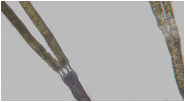
Branching of blade siphons
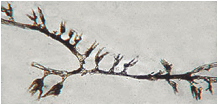

Appendages at base of blade Close-up of appendages at base of blade
Page 125
Udotea conglutinata consists of a fan-shaped blade, generally as wide as high. Blade siphons 40 to 60 microns in diameter, no lateral appendages, and evenly constricted at the dichotomies. Tips of siphons often contorted, one division often shorter. Lateral appendages of stalk are stubby. (See Dawes & Mathieson, p. 100; Taylor, p. 165; Littler & Littler, p. 422)

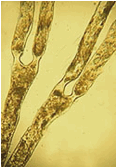
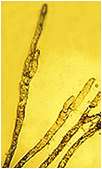
Habit of Udotea conglutinata Constrictions of blade siphons Siphon tips

Lateral appendages of stalk


Lateral appendage of stalk Close-up of lateral appendage of stalk
Page 128
Udotea
cf. caribaea
Udotea cf. caribaea consists of a fan-shaped blade, generally as wide as high. Blade siphons 30 to 50 microns in diameter, no lateral appendages, tightly compact, and evenly constricted at the dichotomies. Lateral appendages of stalk are stubby and blunt. (See Dawes & Mathieson, p. 100; Littler & Littler, p. 422)


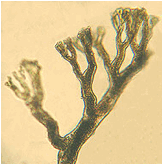
Habit of Udotea cf caribaea Blade siphon Lateral appendages of stalk


Lateral appendages of stalk Close-up of stalk appendages
Choose one of the following options
140a. Calcified stalk of cylindrical segments, apices tufted........................Go to page 142
140b. Prominent stalk with crown of short filaments, the filaments “grouped” into small blades….........................................................................................................Go to page 147
140c. Prominent stalk with a crown of individual filaments…...................Go to page 155
140d. Plant with a short stalk or with stalk appearing in much the same form as the blades, upper part of plant comprised of rounded, triangular, cylindrical, or irregularly shaped segments............................................................................................Go to page 170

![]()
![]()
![]()


Page 142 Page 147 Page 155 Page 170
Page 142
Cymopolia barbata is an attractive plant comprised of heavily calcified cylindrical segments. Segments to 4 mm diameter and 12 mm long. Apices of plant with soft, fine tufts. Apical filaments dichotomously branched ending in threadlike hairs. (See Dawes & Mathieson, p. 106; Taylor, p. 102; Littler & Littler, p. 436)
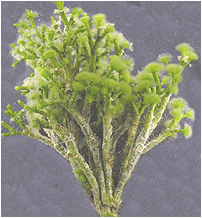
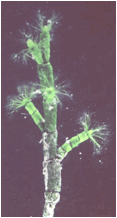
Habit of Cymopolia barbata Portion of plant
Page 147
Rhipocephalus phoenix consists of a prominent stalk (up to 5 cm long) devoid of filaments or branches, and a crown of individual filaments which are fused together into small blades. Siphons 200 to 250 microns near the stalk, smaller near tips. Lower dichotomies of siphons showing little constriction, upper dichotomies evenly constricted. Stalk filaments with lateral appendages. (See Dawes & Mathieson, p. 98; Taylor, p. 174; Littler & Littler, p. 418)

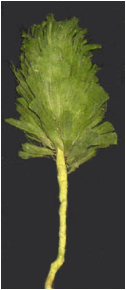
Two specimens showing habit of Rhipocephalus phoenix
155a. Plant with blade siphons evenly constricted at branching points, 100 to 300 microns in diameter, stalk cortical filaments with flat apices.............................Penicillus capitatus
155b. Plant with blade siphons evenly constricted at branching points, 150 to 250 microns in diameter, stalk cortical filaments with pointed apices......Penicillus pyriformis
155c. Plant with blade siphons somewhat moniliform (i.e., beaded), 300 to 500 microns in diameter, stalk cortical filaments with flat apices.......................Penicillus lamourouxii
155d. Plant with blade siphons evenly constricted at branching points, 400 to 800 microns in diameter, stalk cortical filaments with pointed apices.......Penicillus dumetosis


Blade filaments of Two immature Penicillus
Penicillus
capitatus, Penicillus pyriformis, Penicillus dumetosis



Tips of stalk cortical filaments of
Penicillus capitatus Penicillus pyriformis Penicillus dumetosis
Page 157
Penicillus capitatus has a slender, generally cylindrical, stalk (to 9 mm in diameter); stalk often penetrates into cap. The blade siphons are evenly constricted at the branching points, 100 to 300 microns in diameter, and slightly swollen at the apex. Stalk cortical filaments with flat apices. (See Dawes & Mathieson, p. 95; Taylor, p. 171; Littler & Littler, p. 410)

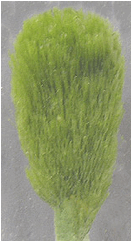
Plant of Penicillus capitatus Cap
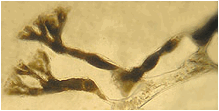
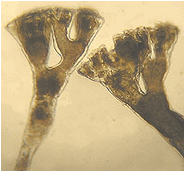
Surface and subsurface cortical filaments of stalk Close-up of surface filaments
Page 160
Penicillus pyriformis is a plant with a prominent cylindrical (to slightly flattened) stalk which may reach 7 mm in diameter. The “brush-like” cap is comprised of stiff siphons that are evenly constricted at the branching points and 150 to 250 microns in diameter. Stalk cortical filaments with pointed apices. (See Dawes & Mathieson, p. 96; Taylor, p. 170; Littler & Littler, p. 412)

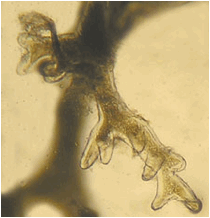
Two plants of Penicillus pyriformis Pointed apices of stalk cortical filaments
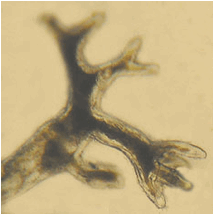
Pointed apices of stalk cortical filaments
Page 162
Penicillus lamourouxii
Penicillus lamourouxii has a stalk that is somewhat flattened and reaches 8 mm in diameter. Cap somewhat rounded in appearance. Blade siphons frequently moniliform (i.e., beaded), 300 to 500 microns in diameter. Stalk cortical filaments with short, flat apices. (See Dawes & Mathieson, p. 96; Taylor, p. 172; Littler & Littler, p. 412)
Page 164
Penicillus dumetosis
Penicillus dumetosis has a large, somewhat flattened stalk that may reach 20+ mm in diameter. The cap is generally taller than wide and is comprised of large siphons. Blade siphons evenly constricted at branching points, 400 to 800 microns in diameter. The stalk cortical filaments with pointed apices. (See Dawes & Mathieson, p. 96; Taylor, p. 172; Littler & Littler, p. 410)


Plant of Penicillus dumetosis Pointed apices of surface cortical filaments of stalk
170a. Plant with segments irregularly rounded, usually ribbed, contorted, connected in disorderly patterns to form clumps; plant will not lay flat.......................Halimeda opuntia
170b. Plant with some lower segments tri-lobed, but with many upper segments cylindrical..................................................................................................Halimeda monile
170c. Plant with tri-lobed segments throughout.................................Halimeda incrassata
170d. Plant with flatted disc-like segments, utricles with prominent spine......Halimeda scabra
170e. Plant with flatted disc-like to triangular segments which are 1.5 cm high and 2 cm wide, top of utricles flat................................................................................Halimeda tuna
170f. Plant with flatted disc-like to triangular segments which are 3 cm high and 4 cm wide, top of utricles flat, subsurface utricles swollen...........................Halimeda discoidea
Page 172
Halimeda opuntia is a plant with segments irregularly rounded, usually ribbed, contorted. Segments heavily calcified, to 10 mm wide and 7 mm high. Branches are connected in disorderly patterns to form clumps; sometimes of considerable size. Due to random and contorted nature, portions of the plant will not lay flat. Top of surface utricles flat. Three to five surface utricles supported by each subsurface utricle (See Dawes & Mathieson, p. 84; Taylor, p. 176; Littler & Littler, p. 406)
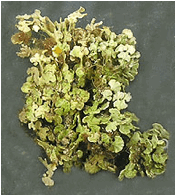

Habit of Halimeda opuntia Small portion of branch showing segments
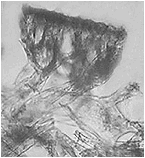

Surface and subsurface utricles Close-up of utricles
Page 174
Halimeda monile is a plant with some lower segments tri-lobed, but with most upper segments cylindrical. Plant to 20+ cm high. Segments calcified. Cylindrical segments to 4 mm diameter, 8 mm long. Top of surface utricles flat. Two to four surface utricles supported by each subsurface utricle. (See Dawes & Mathieson, p. 87; Taylor, p. 182; Littler & Littler, p. 404)

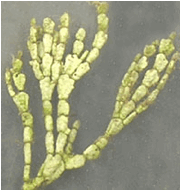

Habit of Halimeda monile Branching Cylindrical segments
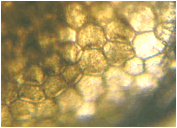

Cell pattern of Halimeda monile Utricles
Page 176
Halimeda incrassata is a plant with tri-lobed segments
throughout. Plant to 20+ cm tall.
Segments oval to kidney-shaped, calcified. Lower segments fused, often whitish. (See Dawes & Mathieson p. 86; Taylor, p.
181; Littler & Littler, p. 402)

Habit of Halimeda incrassata
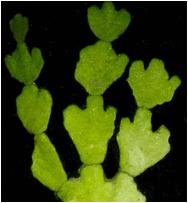
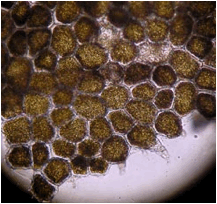
Tri-lobed segments of Halimeda incrassata Close-up of cell pattern
Page 180
Halimeda scabra is a plant of flatted disc-like
segments, the segments lightly calcified, generally thin and pale green. Plant to 20 cm in height, but generally
8 to 15. Each surface utricle with
a prominent spine (See Dawes & Mathieson,
p. 83; Taylor, p. 180; Littler & Littler, p. 406)
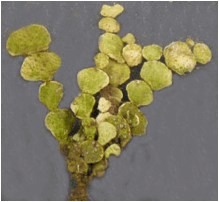
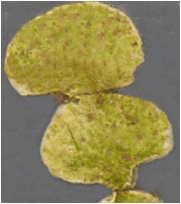
Plant habit of Halimeda scabra Segments of Halimeda scabra
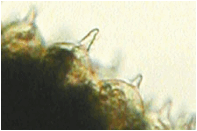

Surface utricles Close-up of surface utricles
Page 184
Halimeda tuna is a plant with flatted disc-like
to triangular segments. Plant to
25 cm high. Branching in one
plane. Segments lightly calcified
and to 1.5 cm high and 2 cm wide.
Top of surface utricles flat.
Two to four surface utricles supported by each subsurface utricle. (See Dawes & Mathieson, p.
83; Taylor, p. 178; Littler & Littler, p. 408)
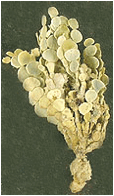
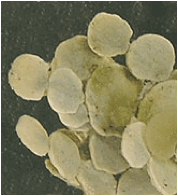
Habit of Halimeda tuna Segments

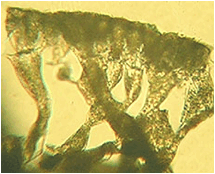
Cell pattern Surface and subsurface utricles
Page 188
Halimeda discoidea consists of large flat segments. Segments are fairly soft, no ribs, disc-like to triangular, to 3 cm high and 4 cm wide, lightly calcified. Infrequent dichotomous branching. Top of utricles flat, subsurface utricles swollen. (See Dawes & Mathieson, p. 82; Taylor, p. 179; Littler & Littler, p. 400)
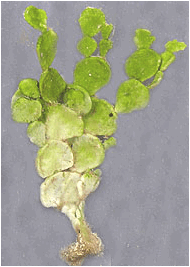
Habit of Halimeda discoidea